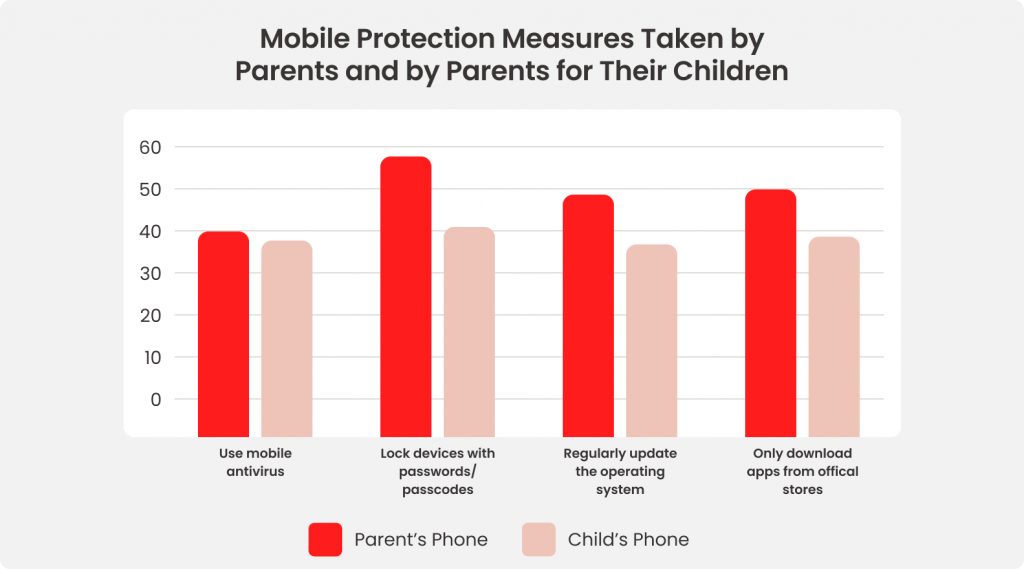While our tweens and tweens seem to grow into adults right before our eyes, their mobile usage matures into adulthood as well—and in many ways, we don’t see.
Girls and boys hit their mobile stride right about the same point in life, at age 15 where their mobile usage jumps significantly and reaches a level that they carry into adulthood, which is one of the several findings we uncovered in our global survey of parents, tweens, and teens this year.
So, what are tweens and teens up to on their mobile devices as they mature? And where do their parents fit in? We asked parents and kids alike. What we found gives us a look into the mobile lives of tweens and teens behind their lock screens.
Mobile is the Most Important Device—Yet Far More So for Kids than Their Parents
For starters, parents and their kids alike say that their mobile device is the most important one in their life. Parents placed mobile in their top two with their mobile device or smartphone at 59% followed their computer or laptop at 42%. Tweens and teens put their mobile device or smartphone at the top of the list as well, yet at a decisive 74% worldwide, followed by their gaming console at 68%.
“Parents and their kids alike say that their mobile device is the most important thing in their life.”
Further, tweens and teens place a higher value on their smartphones to keep them connected with friends and family. Some 59% of parents said mobile was essential in this role, whereas tweens and teens put that figure at 64%. For parents, the runner-up device for keeping connected was the computer or laptop at 42%.
Yet quite interestingly, tweens and teens said their second-most important device for keeping connected with others is their gaming console, at 40%, perhaps indicating gaming’s role in creating and fostering friendships today. Of course, plenty of that gaming is happening on mobile as well, with half of all tweens and teens surveyed worldwide saying that they play games on their smartphones.
It’s No Secret—Kids Will Cover Their Tracks Online. But How?
Broadly speaking, the activities kids do on their phones match up closely with what their parents think they’re doing on their phones. Yet there’s a fair share of secretive activity that happens within that.
Regarding general activity, parents and their tween- and teen-aged children worldwide see eye to eye when it comes to what parents think are their kids’ favorite activities on mobile are and what kids say they actually are:
- Watching short videos (YouTube) – parents think, 66%; kids say 67%
- Browsing the internet – parents think, 64%; kids say 66%
- Streaming music – parents think, 53%; kids say 55%
However, and perhaps unsurprisingly, tweens and teens say they’ve kept some the things they’re watching, browsing, and streaming from their parents. When asked if they sometimes hide specific online activity from their parents, 59% of tweens and teens worldwide said they have done so in some form or other, including:
- Clearing the browser history, 26%
- Close/minimize browser when parent walked in, 21%
- Hide or delete IMs or videos, 15%
- Lie or omit details about online activities, 15%
- Use a device their parents don’t check, 10%
Keeping an Eye on the Kids: Parents Tend to Take a More Hands-on Approach to Monitoring Mobile
Worldwide, monitoring apps rank relatively low when it comes to parents keeping tabs on their children’s mobile usage. Use of parental controls software on smartphones came in at a 27% global average, with India (37%) and France (33%) leading the way, while Japan fell on the low end (12%).
Largely, parents appear to take up this work themselves, citing several other ways they take charge of their children’s time online:
- Limit the time of day or length of time when the child has screen time, 59%
- Check the websites or apps the child visits or uses, 56%
- Look at call records or text messages on a smartphone the child uses, 40%
- Friend or follow the child on social media sites, 35%
- Track the child’s location through GPS apps or software, 30%
Children’s Mobile Devices are Less Protected—and Can Fall Victim to Hacks and Attacks as a Result
Consistent with other research we recently gathered, families are relying on mobile more and more, yet this hasn’t seen an increase in mobile protection for the smartphones they count on.
Our research published in early 20211 found double-digit increases in mobile activities such as online banking, shopping, finances, and doctor visits, all of which can generate high-value data that are attractive to hackers and cybercriminals. Despite this newfound reliance on mobile, many smartphones worldwide remain unprotected. Children’s phones are less protected than their parents’ phones as well.

Taken together, these security lapses can lead to downloaded malware, data and identity theft, illicit crypto mining apps on the device, and other attacks that can put children and families at risk.
Misconceptions about online protection may play a role in these lax measures. This survey found that 49% of parents think a new phone is more secure than a new computer, and 59% of tweens and teens thought the new phone was more secure—both denying the reality that smartphones, and the people using them, are subject to hacks and attacks just like with any other device that connects to the internet.
Amid this climate, more than 1/3 of families reported that a child in their household had been the victim of a financial information leak and 15% stated that there’d been an attempt to steal a child’s online account or identity. With smartphones providing children with a major onramp to the internet, it follows that stronger mobile security could help prevent such attacks from happening.
Tweens and Teens in Several Countries Lean Heavily on Mobile for Online Learning
Protecting mobile devices and the family members who count on them takes on further importance when we consider that children in some nations rely heavily on their smartphones for online learning.
Although using mobile for online learning was relatively low globally at 23%, parents and children in three nations reported a high rate of attending classes and courses on mobile—with India at 54%, Mexico at 42%, and Brazil at 39%, once again posing the possibility that mobile offers many children the most reliable broadband connection required for such instruction. In other words, there are households where broadband comes by way of mobile, rather than a cable or fiber connection.
Meanwhile, other nations saw significantly lower figures for online learning on mobile, such as Germany at 7%, France at 8%, and Japan at 11%. The U.S., Canada, and the UK all reported rates of 17%.
Nurturing Your Kids on Mobile: They’re Growing Before Your Eyes
“With smartphones providing children as a major onramp to the internet, it follows that stronger mobile security could prevent such attacks from happening”
Something we’ve yet to mention here is how much online shopping and banking kids are doing on their mobile devices. No question, tweens and teens are doing those things too at a global rate of 25% and 12% across all age groups respectively. Not surprisingly, those numbers climb as teens approach adulthood. This serves as a reminder that our children are maturing hand-in-hand with their smartphones, which asks a few things of us as parents as they grow and adjust to their mobile world.
As with all things parenting, there are moments of where you have a sense of what’s right for you and your child, yet you’re uncertain how to act on it. That’s definitely the case with smartphones and the internet in general. Despite having grown up alongside the internet over the course of our adult lives, we can still have plenty of questions. New ones. Old ones. Ones we weren’t even aware of until they cropped up.
With that, we’re glad you’re dropping by our blog. And you’re more than invited to visit whenever you can. A big focus of ours is providing you, as a parent, with resources that answer your questions, in addition to articles about online protection in general that simply make for good reading. Our aim is to help you think about what’s best for your family and give you some ideas about how you can see that through, particularly as our children grow in this mobile world of ours. For a deeper dive, you can view the full report here.
